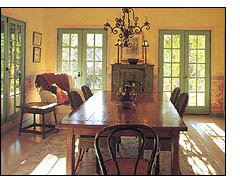
| |
I have heard that understanding "lines" is important in decorating. How can I understand, evaluate and use lines in my own plans?
There are many types of lines to be found in the rooms of your home, potentially evoking certain moods or having the visual power to make your rooms appear larger or smaller. Lines can be found in any room, established by the structural elements of the room such as doors, windows, flooring, paneling, columns, and arches, or by the placement of decorative elements such as patterned wallpaper and the layout of the furnishings.
Straight lines in your rooms tend to be masculine, denoting traditionalism and strength, while curvy lines are more feminine, organic, and dynamic. With straight lines, focal points are easily defined and resolved. With curvy lines in a room, the eye takes longer to discern the image, following the curves and patterns as they resolve.
Straight lines are found in three forms:
Vertical lines: On walls, vertical lines and patterns draw the eyes up and down, adding height to rooms. On floors, vertical lines flow away from the entrance creating a room with more depth. Rooms with vertical lines tend to evoke emotions of vision or restlessness; these are often controlled with the introduction of horizontal lines in window treatments and furniture for balance.
 Horizontal lines: On walls, horizontal lines draw the eyes from side to side making a room appear wider. On floors horizontal lines move across the field of vision creating a room with more width than depth. Horizontal lines evoke emotions of restfulness and harmony, but may cause the room to look too relaxed, even boring. Use of vertical lines in taller furniture, artwork, and wall coverings can enliven the room and avoid it from being too monotonous.
Horizontal lines: On walls, horizontal lines draw the eyes from side to side making a room appear wider. On floors horizontal lines move across the field of vision creating a room with more width than depth. Horizontal lines evoke emotions of restfulness and harmony, but may cause the room to look too relaxed, even boring. Use of vertical lines in taller furniture, artwork, and wall coverings can enliven the room and avoid it from being too monotonous.
Diagonal - On walls and floors, diagonal lines draw the eyes back and forth, following the pattern. The pattern is dynamic and is often used in traffic areas to force movement. Diagonals are perfect for entries and hallways, where movement is promoted, not suggested for use in restful living rooms or bedrooms.
Curved lines are found in many forms, defined by the complexity and tightness of the curves:
Simple flowing curves are found in traditional furniture and wall coverings. These soft curves provide comfort and tranquility to your room.
Curves that are tighter or with dramatic exaggerations in their radii are more modern and dramatic. These modern curves can add drama, motion, and excitement to contemporary, rustic, and even traditional settings.
Top
Back to Interior Design 101
|
|

|





